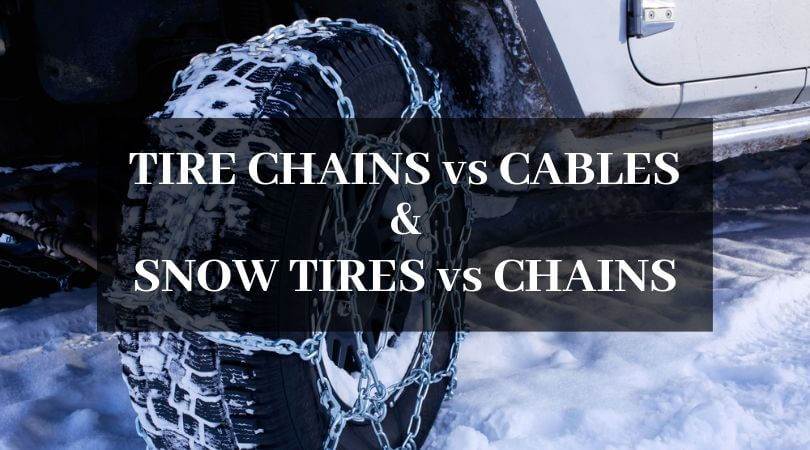Driving in snowy weather is not for the faint of heart. Snowy or icy roads present many challenges to the uninitiated driver. If you live in places with heavy winters, you are probably familiar with the benefits of installing tire chains. These handy tools might give your vehicle a slightly bumpier ride, but nothing beats a set of tire chains to improve traction, grip, and control on snowy or icy roads.
But how about tire cables? Are cables better than tire chains? Most of all, how about snow tires? Will snow tires perform better in winter driving? You’ll find all the answers here.
Tire Chains vs Cables: What’s The Difference?
Tire chains and tire cables are designed to perform similar functions. Both are critical in providing the much-needed traction when navigating on the pavement with deep snow. But even though tire chains and tire cables can accomplish the same task, they couldn’t be any more different in terms of construction.
Tire Chains or Snow Chains

Tire chains are constructed from heavy and large steel links. The chains are designed to wrap around the existing tires in your vehicle to provide more traction.
The downsides of using snow chains are plenty. First off, tire chains are heavier than cables. Snow chains are also more expensive than cables. And perhaps due to the heavier weight, tire chains are a bit difficult to install and will require some practice if you’re a novice.
Despite the inherent downsides, tire chains have their benefits as well. The most important benefit of snow chains is additional traction. Chains offer better traction than tire cables. Due to the heavy-duty steel construction, snow chains are also more durable and can be used repeatedly over the course of many winters.
Tire Cables or Snow Cables

Via Amazon.com
Tire cables can be constructed from a variety of materials. The most basic tire cable is made from steel aircraft cable that is encased in alloy traction coils. Snow cables are many times lighter than chains and can be installed easily with little practice.
But the biggest downside of snow cables is the lack of durability. Snow cables have a tendency to break or warp faster than chains. This makes tire cables only good for occasional use. If you need to drive frequently in adverse weather, tire chains are still the preferred choice.
However, tire cables also have benefits over chains. Cables are lighter and can be stored neatly in the trunk of your vehicle. Snow cables are also more affordable than a set of snow chains.
Should I Use Chains or Cables In My Vehicle?
It will all depend on what you need. If your vehicle is FWD or front-wheel drive, snow chains are a better option. But if you have a 4WD or AWD (all-wheel drive) vehicle, snow cables are a more economical option.
It will also depend on the type of vehicle. If your car or SUV is equipped with larger wheels and low profile tires, tire chains may not be the best option. Since installing tire chains will require sufficient clearance under the fender, snow chains are not an ideal option for lower vehicles or those equipped with large-diameter alloy wheels and sporty tires.
But it doesn’t matter if you choose chains or cables. The trick is to install properly. Make sure to fit snow chains on the driving wheels of your vehicle. Of course, this rule won’t apply if your vehicle is AWD or 4WD. Since all the wheels are driven by the motor, it is better to install snow cables on all four wheels for enhanced traction.
It doesn’t stop there. Like I previously mentioned above, tire cables are only ideal for occasional use. If you’ll be doing a lot of driving over thick snow and mud, tire chains are still the better option. Chains can offer more traction and better durability (and reliability) in this regard.
Snow Tires vs Snow Chains
How about snow tires? Will you still need snow chains if your vehicle is equipped with snow tires? Again, the answer will depend.
Snow tires can be fitted with metal studs. The studs will act as teeth that will literally bite or claw over the ground. Fitting snow tires with metal studs will have the same effect as installing a set of snow chains. Best of all, you can have the studs removed at the tire shop if the weather settles down or if the snow melts.
But the biggest problem with snow tires is the cost. Without a doubt, snow tires are more expensive than an ordinary set of all-season rubber. You’ll need to purchase a complete set of four snow tires to produce the best possible results.
On the other hand, snow chains won’t cost you an arm and a leg. Since a set of high-quality snow tires can easily cost upwards of $500 for a complete set (not including mounting, balancing, and installation), snow chains are a more economical option.
Are All-Season Tires Good Enough For Snowy Roads?
It depends. If driving over very light snow, all-season tires are good enough as long as the tread depth is not below 4/32”. On the other hand, if the temperature drops below 15 F and the roads are covered in inches of snow, it is safer to upgrade to snow tires.
As a golden rule of thumb, make sure the tires are properly inflated. The tire pressure will drop an average of two PSI for every 10 F drop in temperature. Make sure to always check the tire pressure before driving. It is also a good idea to recheck the air pressure every time you fill-up the tank with petrol.
But if the weather really gets bad and your car is not equipped with snow tires, tire chains or cables will offer a more economical and easier solution.

